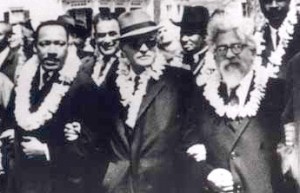This post was written with my friend and colleague, Reverend Lillian Daniel.
The late great Abraham Joshua Heschel was once asked why he devoted so much time to interfaith dialogue. He answering by recounting part of his family history. “When the Nazis came for my parents,” he wrote, “they had no one to call. They did not know the local minister. They could not call the mayor. They could not call the local parish. Now,” he said, “if something happened, I could pick up the phone and talk to half a dozen Christian leaders in 15 minutes.”
As American clergy of a younger generation, a rabbi and a pastor in the suburbs of Chicago, we didn’t imbue our own dialogue with any kind of lifesaving importance. We knew it would be interesting, fun even, to talk about Maundy Thursday and Passover, and then share it with our congregations in the context of worship.
But we found ourselves confronting a sometimes tragic history between our faiths. We asked some piercing questions. We found ourselves learning from one another.
We probably began with the lofty goal of modeling meaningful religious conversations for our congregations. But after trying it out, we both realized we were learning and changing.
Because whether you are clergy in the pulpit or members in the pews, we all wince at the excesses – the pistol packing pastor who wants to burn the Koran, the irresponsible leaders who believe every inch of the holy land belongs to them, the violent zealots who think killing the innocent is an acceptable price to pay for making a religious point.
We soon realized that as clergy, we would not be “models of dialogue” in the worship services, but fellow travellers, just learning how to live. And nothing made that clearer than returning to our respective homes that Sunday to hear the horrifying news of shootings at the Jewish Community Center in Kansas.
So, having worshipped with one another’s congregations on the Sabbath before Passover and on Palm Sunday: What did we learn?
1. If you can’t say it in front of the rabbi/or the pastor, don’t say it all. We don’t need to water down our unique beliefs. We need to affirm them with openness and dignity. But having a clergy guest makes us look at what we are saying, and not saying, with more clarity. We need to talk about what is difficult as we search for what we share.
2. There is still much work to be done: Much of the interfaith dialogue over the last half century has been at the organizational level. Numerous leaders of big groups have spoken with one another. The benefits have been tangible. Yet, much of the deeper understanding and knowledge of one another’s faith has not spread to the pews. We were moved by the questions members of our congregations asked us and one another. Jews can learn more about major aspects of Christianity like the Resurrection, and Christians can learn more about Jewish texts like the Talmud. This knowledge need not threaten our uniqueness, but bring us closer to the God who created us all.
3. Ask the awkward questions: We each tried to surprise each other with a difficult question. Evan asked Lillian about Satan. Lillian asked Evan if he believed the Ten Plagues really happened. Our answers may surprise you, and we have several more in the works.
4. It’s not theoretical, it’s the world we live in.
Denominational pronouncements are not where the rubber hits the roads. We have to take this to the thoughtful and curious people in our congregations. The members of our congregations are not engaged in interfaith dialogue. They live, as we do, in a multi-faith world. It’s not about talking, it’s about living.
And in the wake of the recent tragedy in Kansas, two clergy and two congregations realized that Heschel’s remarks do speak to us today. This work is more lifesaving than we thought.
You can watch the dialogue sermons from the first Sunday in Lent and from Palm Sunday, by Rev Lillian Daniel and Rabbi Evan Moffic, at First Congregational Church, Glen Ellyn, Illinois.


